Unit of Assessment:
Research categories:
?Chemistry
Chemistry, Physical (2)
Engineering
Energy & Fuels (3)
Materials Science
Materials Science, Multidisciplinary (5)
Nanoscience & Nanotechnology (2)
Physics
Physics, Applied (5)
Impact locations:
?Asia
China (Mainland China) (2), Zhejiang (1), Xiuzhou Qu (1)
North America
United States (1)
Case Study
Production and commercialization of flexible CIGS thin film solar cells
1. Summary of the impact
Professor Xudong Xiao’s team has solved material and processing problems and developed the technology to fabricate flexible, light-weight and stable CIGS solar cells and modules with internationally competitive energy conversion efficiency and world-leading module dimensions. 56 patents were granted to relevant research. They launched a start-up company, Shinetech, in Zhejiang in 2015, with 60 employees producing 5W rollable solar chargers and 24W flexible charging stations for multiple field users, generating RMB2.4M annually. Shinetech has promoted public awareness of photovoltaic (PV) solar energy via media interviews. The commercial success of this research project has led to economic, welfare and environmental impacts.
2. Underpinning research
Despite being based on a mature technology, silicon-based solar cells have not been widely used due to their limited flexibility and high material consumption. CIGS (Copper Indium Gallium Selenium) is an attractive alternative PV material due to these features: (a) high conversion efficiency; (b) band gap tunable by position-dependent In/Ga proportion; (c) competitive cost; (d) light, foldable and bendable; (e) stable and pollution-free compared to other non-silicon alternatives, e.g. cadmium telluride (CdTe). The research team led by Prof. Xiao (Professor, Department of Physics, [2007-]) has developed a novel CIGS structure, and the technologies to process the materials and optimize material properties since 2008, with funding from CUHK, this UoA at CUHK, RGC, and the Innovation and Technology Commission. Xiao’s team has solved key problems that are critical to the establishment of the relevant industry in China.
- Two laboratory-scale set-ups were established in CUHK and in the CUHK lab in Shenzhen Institute of Advanced Technology (SIAT). These laboratories can grow various functional layers (sputtering molybdenum for back electrode, co-evaporating Cu, In, Ga, and Se for CIGS absorber, chemical bath deposition for CdS buffer layer, sputtering i-ZnO and Al:ZnO for window layer, and electron beam deposition of Ni/Al/Ni metal grid and MgF2 antireflection layers) on 100 cm2 substrates, which allow industrial scale-up. Key findings were deployed in collaboration with Chinese vacuum production companies to manufacture key equipment (e.g. high-temperature evaporation source).
- Xiao’s team grasped the technological know-hows and produced advanced CIGS solar cells: 17% efficiency in 2010, which was the best in the Greater China region and close to the then 19.9% world record; 21.3% in 2016, close to the then record of 22.6% reached by Germany’s ZSW only after four decades in CIGS research.
- Xiao’s team made innovations in large active-area cells’ structure [3.1] and improved the conversion efficiency by a novel approach on fabrication of CIGS cells at low glass-substrate temperatures [3.2].
- Xiao’s team developed technology to optimize the spatial variation of the band gap during deposition for submicron CIGS films, adding to their efficiency [3.3].
- Xiao’s team identified co-evaporation for CIGS layer growth as the best technology for conversion efficiency. They developed a new route for fabricating high-quality Zn(S,O) buffer layer at high deposition temperature on CIGS solar cells [3.4,3.5] and a new route for absorber growth with enhanced photocurrent [3.6].
- Since 2012, Xiao’s team at the CUHK lab in SIAT designed a pilot line with all-Chinese technologies to produce 40 cm × 60 cm modules on glass substrates. In 2014, the pilot line achieved such industry-scale modules with efficiency over 10% using their novel linear evaporator source, a milestone for CIGS commercialization.
- The CUHK team has developed the technology on flexible substrates (stainless steel, titanium, polyimide foils). Technology for producing reasonably industrial modules has been developed (40 cm width rolls industrially). Technology routes towards ultrathin CIGS film and Cadmium-free technology were developed.
- Innovations by Xiao’s team are protected by 55 Chinese patents and 1 US patent (detailed in section 5).
3. References to the research
3.1 Ling Yin, Kang Zhang, Hailin Luo, Guanming Cheng, Xuhang Ma, Zhiyu Xiong, Xudong Xiao, “Highly efficient graphene-based Cu(In,Ga)Se2 solar cells with large active area”, Nanoscale, 6 (18): 10879–86 (2014).
3.2 Kang Zhang, Chunlei Yang, Ling Yin, Zhuang Liu, Qiuming Song, Hailin Luo, Zhiyu Xiong, Miaomiao Xu, Xudong Xiao, “Fabricating highly efficient Cu(In,Ga)Se2 solar cells at low glass-substrate temperature by active gallium grading control”, Solar Energy Materials and Solar Cells, 120, 253–258 (2014).
3.3 Shihang Yang, Jiakuan Zhu, Xieqiu Zhang, Xuhang Ma, Hailin Luo, Ling Yin, Xudong Xiao, “Bandgap optimization of submicron thick Cu(In,Ga)Se2 solar cells”, Progress in Photovoltaics: Research and Applications, Vol. 23, Issue 9, 1157–1163 (2015).
3.4 Jiakuan Zhu, Shihang Yang, Tsz Ki Lau, Jiangquan Mai, Hailin Luo, Xinhui Lu, Xudong Xiao, “New route for fabrication of high quality Zn(S,O) buffer layer at high deposition temperature on Cu(In,Ga)Se2 solar cells”, IEEE Journal of Photovoltaics, 7, 651–655 (2017).
3.5 Jianmin Li, Lan Huang, Jie Hou, Xiao Wu, Jiabin Niu, Guilin Chen, Junbo Gong, Yifan Kong, Xudong Xiao, “Effects of Substrate Orientation and Solution Movement in Chemical Bath Deposition on Zn(O,S) Buffer Layer and Cu(In,Ga)Se2 Thin Film Solar Cells”, Nano Energy 58, 427–436 (2019).
3.6 Junbo Gong, Yifan Kong, Jianmin Li, Kefan Wang, Xiaodong Fan, Xiangqi Wang, Zengming Zhang, Zejun Ding, Xudong Xiao, “Enhancing photocurrent of Cu(In,Ga)Se2 solar cells with actively controlled Ga grading in the absorber layer”, Nano Energy 62, 205–211 (2019).
4. Details of the impact
Professor Xiao and his team have demonstrated that CIGS is a promising candidate for future solar and photovoltaic (PV) applications due to its high conversion efficiency, flexibility and feasibility of industrialization at low production cost. The works of Xiao’s team have led to the following impacts:
Impact on the economy:
Since 2008, Xiao’s works on CIGS have generated 55 Chinese patents (39 were granted within the RAE impact assessment period) and 1 US patent [5.1].
A start-up company has been established to take the R&D results towards commercialization. The company, Shinetech New Energy Co. Ltd., is supervised by Prof. Xiao and operated by a number of CUHK graduates trained in this field. Launched in Zhejiang in 2015 with a registered capital of RMB 52M and cumulative provincial government funding of over RMB 34.8M, Shinetech now has about 60 employees with more than 10 being PhD or MS graduates [5.2]. It has designed and constructed production lines with proprietary and domestic technology which are worth more than RMB 40M [5.2], with capacity to produce 2 MW flexible CIGS panels annually. The rather specialized markets for CIGS allow premium price, currently around RMB 50/W, which is about 15 times higher than the bulk PV market, providing sufficient margin for the industry to take hold. At present, all the facilities have been installed and tested, and it has an annual capacity of producing 2MW flexible CIGS panels. Two types of products are being produced: 5W solar chargers for consumer electronics that can be rolled up to the size of a flash-light, and 24W flexible charging stations for multiple field users. Shinetech produces 1000/month for the former and 400/month for the latter, generating a monthly income of about RMB200,000 currently. The R&D, the high-tech enterprise, the production facility and the products have won a number of national, provincial and city awards [5.3], including the China High Technology Enterprises, Zhejiang Provincial Award for Leading Innovation Team; Zhejiang Provincial Key Enterprise Lab; Zhejiang Provincial Level Enterprise Research Institute; City of Jiaxing High-Tech R&D Center; Xiuzhou District Enterprise Research Center; and Provincial Merit Award in the 5th China Innovation and Entrepreneurship Competition. Xiao’s team has opened up a novel direction with new applications for niche PV products, and laid the foundation for future developments into the mainstream PV market.
Impacts on public welfare:
Raising public awareness of the new generation of solar cells
The CIGS technology and the establishment of Shinetech have been featured prominently in local and national press, including featured articles on Jiaxing Daily in 2016 [5.4], People's Daily Online in 2017 [5.5] and a review article on Tencent (QQ news) in 2018 [5.6]. A quote from QQ news best summarizes the advancement of Prof. Xiao’s CIGS research, “CIGS from Shinetech is much competitive than other similar products listing due to the novel ultrathin structure and high quality.” These news reports have raised public awareness and enhanced their understanding on the rise of Chinese advanced technology enterprises and the significance of CIGS solar cell innovation on developing sustainable energy sources.
Impacts on practitioners and services:
Influencing professional standards
Breakthroughs on CIGS development by Xiao’s team have contributed to launches of new products on the PV markets. The unique flexibility, light weight and long stability of CIGS enable novel products for specialized markets and applications such as solar chargers, solar automobiles, solar tents, unmanned aerial vehicles, airships, and other mobile power generators.
Impacts on environment:
Development of clean energy
Solar PV is an indispensable and growing component of a sustainable and CO2-free energy future. PV, currently based mainly on silicon and to some extent CdTe and CIGS, currently accounts for 2% of electricity generation globally, and up to around 7% in some countries with aggressive adoption. In addition, the highly polluting Cd technology is no longer supported in China. The trend of developing CIGS as the future mainstream PV material has been established. The endeavor of Xiao’s team to optimizing the CIGS production contributes to large-scale applications of CIGS products. The R&D and commercialization carried out by Xiao’s team have established CIGS-based solar energy as a promising alternative renewable and clean energy source in the near future.
5. Sources to corroborate the impact
5.1 List of 55 Chinese patents and 1 US patent generated from Xiao’s CIGS research (2019)
5.2 Shinetech New Energy Co. Ltd. Company brochure (2019)
5.3 Certificates of awards won by Shintech (2019)
5.4 Featured article on Jiaxing Daily (2016)
5.5 Featured article on People's Daily Online (2017)
5.6 Review article on QQ news (2018)

